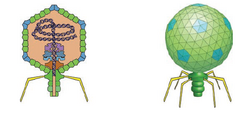Biology:Autographiviridae
| Autographiviridae | |
|---|---|

| |
| Virus classification | |
| (unranked): | Virus |
| Realm: | Duplodnaviria |
| Kingdom: | Heunggongvirae |
| Phylum: | Uroviricota |
| Class: | Caudoviricetes |
| Order: | Caudovirales |
| Family: | Autographiviridae |
| Genera | |
|
see text | |
| Synonyms | |
| |
Autographiviridae is a family of viruses in the order Caudovirales. Bacteria serve as natural hosts. There are 373 species in this family, assigned to 9 subfamilies and 133 genera.[1][2]
History
Since the 1990s, the term "T7 supergroup" has been coined for the expanding group of bacteriophages related to coliphage T7, as members of the family Podoviridae. Enterobacteriaceae phages SP6 and K1-5 were the first to be considered as an estranged subgroup of the "T7 supergroup".[3] Pseudomonas phage phiKMV also shared commonalities at the genome organizational level. As such, based on the available morphological and proteomic data, this clade of viruses was established as a subfamily of the family Podoviridae. The subfamily was later raised to the level of family in 2019.[4]
Etymology
The name of this family, termed Autographiviridae, refers to the “auto-graphein” or “self-transcribing” phages which encode their own (single subunit) RNA polymerase, a common characteristic among its members.[citation needed]
Structure
Viruses in Autographiviridae are non-enveloped, with icosahedral and Head-tail geometries, and T=7 symmetry. The diameter is around 60 nm. Genomes are linear, around 40-42kb in length.[1]
Life cycle
Viral replication is cytoplasmic. DNA templated transcription is the method of transcription. The virus exits the host cell by lysis, and holin/endolysin/spanin proteins. Bacteria serve as the natural host. Transmission routes are passive diffusion.[1]
Taxonomy
The following subfamilies are recognized:[2]
- Beijerinckvirinae
- Colwellvirinae
- Corkvirinae
- Krylovirinae
- Melnykvirinae
- Molineuxvirinae
- Okabevirinae
- Slopekvirinae
- Studiervirinae
The following genera are unassigned to a subfamily:[2]
- Aegirvirus
- Anchaingvirus
- Aqualcavirus
- Ashivirus
- Atuphduovirus
- Ayakvirus
- Ayaqvirus
- Banchanvirus
- Bifseptvirus
- Bonnellvirus
- Cheungvirus
- Chosvirus
- Cuernavacavirus
- Cyclitvirus
- Ermolevavirus
- Foturvirus
- Foussvirus
- Fussvirus
- Gajwadongvirus
- Gyeongsanvirus
- Igirivirus
- Jalkavirus
- Jiaoyazivirus
- Kafavirus
- Kajamvirus
- Kakivirus
- Kalppathivirus
- Kelmasvirus
- Kembevirus
- Krakvirus
- Lauvirus
- Limelightvirus
- Lingvirus
- Lirvirus
- Lullwatervirus
- Maculvirus
- Napahaivirus
- Nohivirus
- Oinezvirus
- Paadamvirus
- Pagavirus
- Pairvirus
- Pedosvirus
- Pekhitvirus
- Pelagivirus
- Percyvirus
- Piedvirus
- Podivirus
- Pollyceevirus
- Poseidonvirus
- Powvirus
- Pradovirus
- Qadamvirus
- Scottvirus
- Sednavirus
- Serkorvirus
- Sieqvirus
- Stompelvirus
- Stopalavirus
- Stopavirus
- Stupnyavirus
- Tangaroavirus
- Tawavirus
- Tiamatvirus
- Tiilvirus
- Tritonvirus
- Voetvirus
- Votkovvirus
- Waewaevirus
- Wuhanvirus (not to be confused with severe acute respiratory syndrome coronavirus 2)
References
- ↑ 1.0 1.1 1.2 "Viral Zone". ExPASy. http://viralzone.expasy.org/all_by_species/709.html.
- ↑ 2.0 2.1 2.2 "Virus Taxonomy: 2020 Release". International Committee on Taxonomy of Viruses (ICTV). March 2021. https://ictv.global/taxonomy.
- ↑ D., Scholl; J., Kieleczawa; Kemp, P.; Rush, J.; Richardson, C. C.; Merril, C.; Adhya, S.; Molineux, I. J. (2004). "Genomic analysis of bacteriophages SP6 and K1-5, an estranged subgroup of the T7 supergroup". Journal of Molecular Biology 335 (5): 1151–71. doi:10.1016/j.jmb.2003.11.035. PMID 14729334.
- ↑ Kumar, R.; Tao, M. (1975-11-20). "Multiple forms of casein kinase from rabbit erythrocytes". Biochimica et Biophysica Acta (BBA) - Enzymology 410 (1): 87–98. doi:10.1016/0005-2744(75)90209-0. ISSN 0006-3002. PMID 76. https://pubmed.ncbi.nlm.nih.gov/76.
External links
Wikidata ☰ Q16835943 entry
 |

